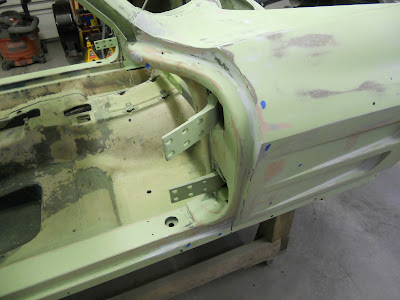Now it's time for glazing. Glazing is a catalyzed filler like Bondo but it has a much smoother consistency like toothpaste. There are several brands on the market, we chose the one shown below. Icing is used to fill pin holes and other minor imperfections. It can be applied over fiberglass or primer which is perfect for us.
We made a couple test batches to find out how long it takes the glazing to set. It's about 3 minutes. Since we're looking for pin holes and set time is short, I decided to examine the car first and put a small piece of tape next to anything that needed glazing. Our glazing is white and it has already been applied in this picture.
Both door jambs had several areas that needed help. As you recall we did a lot of fiberglass repair in these areas.
Here's the passenger side.
The glazing worked great in the corners on both front fender louvers.
After the glazing hardened the tape was removed and the sanding began.
It took a few hours to complete the car.
Every inch of the car was inspected and glazed as needed. Much of this was done while scooting around on a floor creeper. The good news is the first round of glazing is now done.
Next we re-shoot the car with primer. I promise!



















